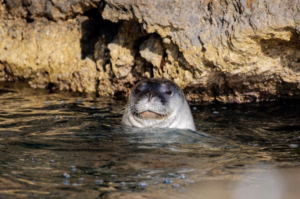In order to better protect the Mediterranean monk seals, it is vital to better understand this key species. The matter is urgent, as very few of these animals remain today. They are considered “endangered” on the International Union of Conservation of Nature’s (IUCN) red list. To reach this goal set by the Octopus Foundation, its team traveled to the Ionian Islands, in Greece, between the 25th of May and 6th of June 2018. We established a partnership with local actors and tested cutting-edge tools, in an effort to have a better knowledge of their true numbers.
Since the 1st of June 2018, two sets of autonomous monitoring systems have been installed in two distinctive caves where monk seals were seen in the past. On the first site, an infrared camera is used 24/7 to verify if a seal is resting or not on the beach at the far end of the cave. A second camera connected to the same system is set up right outside, high on the adjacent cliff. The latter camera is useful to monitor the human activities in the area, as well as the weather conditions.
These monitoring systems are autonomous in energy, powered by solar panels. They are set to record images at regular intervals, which are then automatically sent via 3G/4G router to a remote server. The database can be accessed by biologists for further study. A micro-computer, programmed by the Foundation’s team, was added to manage the power consumption, as well as record the photos on a USB key in the event of local telephone network failure. We plan to open source the entire monitoring systems at the beginning of 2019 to all of the scientific community.
This initial testing phase was successful, as we photographed a monk seal in the cave on the 21st of October. This specimen showed an interest in this particular cave once the summer touristic flow had ended. Also, the weather was particularly bad at the time. Without jumping to conclusions, it is fair to think that the seal needed to rest from the elements.
During the June field mission, the Octopus Foundation also used consumer aerial drones (less than CHF 1’000.-) to test their ability to locate and observe, from the sky, the behaviour of monk seals in their natural habitat. Two pilots were each in charge of their own drone, in order to relay one another for about two hours without losing the animals. Exceptional footage was brought back from this experience, and can be seen here. The images will be used to raise the public’s awareness on the monk seal’s dire situation, and we hope towards a better protection in the future.
The initial testing phase of the monitoring system ended on the 30th of November. Over the coming winter, the Octopus Foundation’s technical team will analyse the results and prepare the modifications for the next season. Small upgrades will be brought to the technology, to increase their resilience and overall effectiveness. In the Spring of 2019, a new zone will be monitored with a third system.
This project is a collaborative effort of the Octopus Foundation, the IUCN and SmileWave fund, under scientific supervision of the Greek biologists of MOm, Archipelagos and Kosamare.
